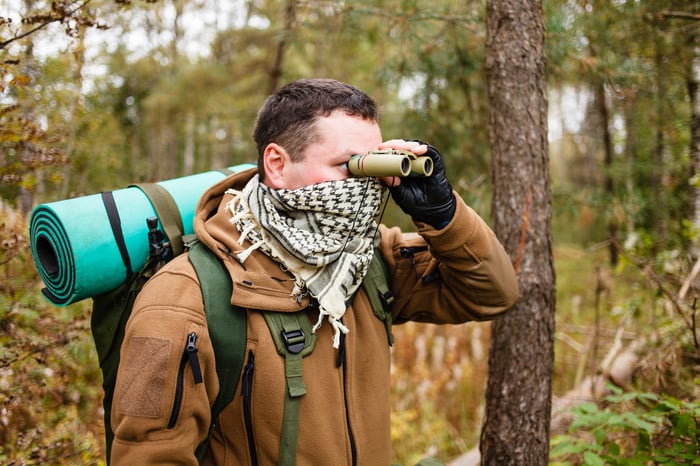Smith & Wesson Holding (SWBI 1.82%) shareholders just overwhelmingly approved a change in the company's name, so that on Jan. 1, the gunmaker will instead be called American Outdoor Brands. Since its corporate identity stretches all the way back to 1852 and encompasses a brand that is not only well known in the firearms industry (and in some ways is synonymous with it), but is also identifiable by most people outside of the industry, it's a move that shouldn't be taken lightly.

Smith & Wesson will soon be charting a new path as it enters the rugged outdoors market as American Outdoor Brands. Image source: Getty Images.
Specifically, with the start of the new year, investors can expect the following:
- The name of the holding company will change from Smith & Wesson Holding Corporation to American Outdoor Brands Corporation.
- The stock, while still trading on the Nasdaq exchange, will see a ticker change from SWHC to AOBC.
- The company's firearms will still be marketed and sold under the Smith & Wesson brand.
What you should do
If you own shares of Smith & Wesson and plan to continue to do so after it starts calling itself American Outdoor Brands, you don't need to do anything, as your stock brokerage ought to automatically update your accounts with the new name and ticker symbol.
But all investors should consider what the name change means to the company's operations and its future growth prospects, and whether it will make American Outdoor Brands a good stock to own in the future. The answers you come up with may lead you to sell the stock -- or buy more.
Why Smith & Wesson changed its name
The gun business has been very good to Smith & Wesson. Over the past decade, firearms sales have soared, with the gunmaker generating, in the first six months of fiscal year 2017, 75% more in revenues than it did for all of 2007. Demand in more recent periods has been white-hot.
According to the FBI, background investigations of people wanting to buy firearms have been setting new monthly records for 19 straight months; by the end of November the law enforcement agency had already conducted more investigations in 2016 than it did for all of last year. Both Smith & Wesson and industry peer Sturm, Ruger (RGR 1.10%) see no real sign of demand letting up anytime soon.

Data source: FBI. Chart by author.
Yet it's also true that gun sales are lumpy, or rather come in waves. Immediately after the Sandy Hook shootings in 2012, for example, there was a rush to buy guns over fears of new ownership restrictions being imposed. And while there was an uptick in violent crime last year, society is much safer today than it was 10 years ago, with incidence of murder, rape, and robbery 16% lower than in 2006.
The rugged outdoors business can help smooth out the peaks and valleys of the gun business. At $60 billion, the addressable market for outdoors gear and apparel is some four times larger than the market for firearms, meaning Smith & Wesson has a greater chance for growth tapping into survivalism, extreme outdoor activities, and even camping than it does by remaining a firearms pure play like Ruger.
Instead, it can follow the model of Vista Outdoor (VSTO 0.63%) and sell rugged outdoors equipment, as well as firearms -- Vista owns both Savage Arms and Federal Premium Ammunition -- and still enjoy significant growth.

Image source: Getty Images.
Equally importantly, it can stop the volatile swings in Smith & Wesson's stock price that often follow mass shooting incidents or low background-check numbers. After Trump's election, Smith & Wesson's stock tumbled hard (and Ruger's too), but Vista barely budged. Over time, by calling itself American Outdoor Brands, Smith & Wesson may be able to disassociate its stock from the gun issue, even if it still primarily generates most of its revenues from their sale.
Still a story behind the stock
Since its guns will still be sold under the Smith & Wesson brand, the company shouldn't lose out with the consumers who matters most to it -- gun buyers -- and the new corporate identity could open up to it a whole new customer base that won't necessarily be put off by its relationship with firearms.
I disagreed with the decision to change the name of the company because it is a bit of gamesmanship aimed at burying the association with its firearms heritage, as well as trying to break into a highly competitive new industry. But ultimately, changing the name may not backfire on American Outdoor Brands; it may instead blaze a path to greater growth.





